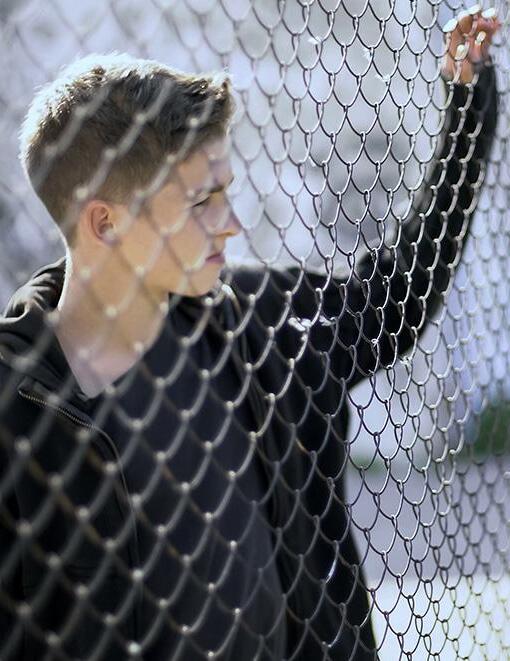

My Honor
BY RICHARD E. SHERMANSKI, JR., ESQ.
IN THE LANDSCAPE of American jurisprudence, the phrase “justice for all” sometimes rings hollow. Growing up in Luzerne County, Pennsylvania, I unwittingly lived in the shadow of what would become one of the most notorious judicial scandals in American history. Years later, as I now volunteer as a judge with Baltimore City Teen Court, I’ve come to understand how formative those early experiences were in shaping my commitment to ethical justice.
THE SHADOW OF CORRUPTION
Luzerne County gained national infamy through the “Kids for Cash” scandal. Between 2003 and 2008, county judges Michael Conahan and Mark Ciavarella orchestrated a scheme that would shake the foundations of our judicial system. These judges received kickbacks for sending juveniles to privately owned detention facilities, effectively selling children’s freedom for personal profit.
The statistics remain staggering and sobering: more than 2,500 children had their lives altered, with over 6,000 cases tainted by corruption. Over 50 percent of the children who appeared before Judge Ciavarella lacked legal representation; 60 percent were removed from their homes.1 These weren’t just cases; they were childhoods interrupted, futures derailed, and families devastated.
I didn’t fully comprehend at the time what a bullet I had dodged. During high school, I found myself in a fight that resulted in a three (3) day suspension. It was a minor infraction that, under different circumstances, had I appeared before either Conahan or Ciavarella, could have resulted in incarceration and a permanently altered trajectory for my life. It wasn’t until years later that I realized the gravity of what had happened in my county and how close I had come to potentially being one of those statistics.
WITNESSING THE AFTERMATH
During my final year of law school, I had the opportunity to clerk for Judge William Amesbury, one of the judges who replaced Conahan and Ciavarella after their removal from the bench. It was there that I truly began to understand the scope of the damage inflicted upon my community. Judge Amesbury faced the monumental task of not only handling new cases but also rebuilding trust in a system that had fundamentally betrayed its constituents.
Working alongside Judge Amesbury, I saw firsthand the lingering effects of judicial corruption. Families approached the court with deep suspicion. The healing process was slow and painful, but it reinforced the critical importance of integrity within our justice system.
I also had the honor of serving as a Juvenile Public Defender while in law school. This experience brought me face-to-face with the vulnerability of children navigating a complex legal system designed for adults. I witnessed their fear, confusion, and desperate need for an advocate who would stand beside them. The experience was
transformative—I realized that for many of these young people, seeing someone dedicated to their defense was perhaps their first encounter with fairness in an otherwise intimidating process.
RESTORATIVE JUSTICE IN BALTIMORE
Today, I have the privilege of serving as a Judge with the Baltimore City Teen Court through the MYLaw Organization. This program represents everything, I believe our juvenile justice system should be—focused on rehabilitation rather than punishment, community restoration rather than isolation, and opportunity rather than penalty.
Teen Court is a formal diversionary program that accepts referrals from the Baltimore City Police Department, Baltimore City School Police, State’s Attorney’s Office, and Department of Juvenile Services. Its purpose is straightforward yet profound: to divert youth away from the traditional juvenile justice system, minimize recidivism, and create positive impacts on young lives.
What makes this program special is its foundation in restorative justice principles. Young respondents repair the harm done to the community through community service and educational programming. When they successfully complete their sanctions, they leave with no record of the arrest that led to their involvement in Teen Court—a clean slate that preserves their future opportunities.
The program’s structure is a lesson in peer accountability and community involvement. Youth volunteers between the ages of 11 and 17 serve as jurors and jury forepersons. With the exception of an adult judge and courtroom facilitator, young people run the hearings themselves. They earn service learning hours for their participation while developing communication and networking skills that will serve them throughout their lives.
As an adult volunteer, my role is to guide rather than direct these hearings. I sit alongside other judges, magistrates, attorneys, and law students who share my commitment to mentoring the next generation through example.
The young respondents typically range from 11 to 17 years old and either reside or attend school in Baltimore City. To qualify for the program, they must have been referred by Baltimore City Police, School Police, the State’s Attorney’s Office, or the Department of Juvenile Services. They must have admitted involvement and accepted responsibility for the actions which led to their arrest, been charged with a misdemeanor, have fewer than four prior misdemeanors, be willing to complete sanctions imposed by their peer jurors, and have a parent or guardian willing to participate in the Teen Court process.
MEASURING SUCCESS BEYOND STATISTICS
While I am not an “official” judge in the traditional sense, I can’t help but smile every time the student jurors and respondents address me as “Your Honor.” It’s a small formality that carries significant weight in these proceedings. In my role, I strive to make each young person
1 “Investigative Reporting Uncovers Judicial Corruption in Juvenile Cases.” Factual America, 2025, https://www.factualamerica.com/journalistic-landmarks/investigative-reporting-uncovers-judicialcorruption-in-juvenile-cases
Teen Court's purpose is straightforward yet profound: to divert youth away from the traditional juvenile justice system, minimize recidivism, and create positive impacts on young lives.
feel heard and understood. I want them to recognize that this program isn’t about punishment but rather about giving them the opportunity to learn from their experiences and avoid any longlasting effects of one bad decision.
The success of Teen Court speaks for itself. Our one-year average recidivism rate of 12% is a fraction of the city’s 44% juvenile recidivism rate.2 But statistics, while important, don’t capture the human element of what happens in these hearings.
Some of our most powerful success stories involve youth who join as respondents and transition to volunteers. Having experienced the process from both sides, they often become its most effective advocates and mentors. They understand better than anyone the transformative potential of being held accountable by peers rather than punished by a system.
For over a year now, I’ve presided over these cases, and while I don’t have a chamber or wear a robe—I do have a gavel but have never used it—I have found profound fulfillment in my work. Each time I call a hearing to order, I carry with me the shadows of Luzerne County—not as a burden, but as a reminder of what happens when justice loses its way. I think about what might have happened to the thousands of children who stood before judges who had abandoned their oath, and I recommit myself to ensuring that the young people before me today experience justice at its best.
FULL CIRCLE
There’s a certain symmetry to my journey from a high school student in Luzerne County who narrowly avoided the corrupt judicial system to a volunteer judge helping young people in Baltimore avoid the traditional juvenile justice system altogether. The path between these points wasn’t direct, but it was purposeful.
What I witnessed in Pennsylvania—both the corruption and the painful rebuilding—instilled in me a deep appreciation for judicial ethics and the awesome responsibility that comes with making decisions that affect young lives. What I practice in Baltimore is the application of those lessons: justice tempered with mercy, accountability balanced with opportunity, and community healing prioritized over punitive measures.
The “Kids for Cash” scandal revealed how vulnerable children are within our justice system, how easily they can become commodities rather than individuals deserving of care and consideration. Teen Court demonstrates an alternative approach—one that recognizes young people’s capacity for
growth, change, and positive contribution.
I often think about the contrast between Judge Ciavarella’s courtroom and the Teen Court where I now volunteer. In the former, children entered without representation, facing a judge who had already decided their fate based on personal gain. In the latter, young people enter a room of peers guided by adults committed to their success, where the goal is restoration rather than retribution.
LOOKING FORWARD
As I continue this work, I remain mindful of both its limitations and its possibilities. Teen Court isn’t a panacea for all the challenges facing juvenile justice, but it represents a meaningful step toward a more humane, effective approach. The program’s success in reducing recidivism demonstrates that treating young offenders with dignity and providing them with opportunities for redemption yields better outcomes than harsh punishment.
My experience has taught me that honor in the legal profession isn’t just about avoiding corruption—it’s about actively pursuing justice in its truest form. It’s about recognizing that each person who participates deserves to be seen as an individual with inherent worth and potential.
The judges of Luzerne County betrayed their oath and robbed thousands of children of their futures for personal gain. Their actions stand as a stark reminder of what happens when those entrusted with upholding justice abandon their principles. In contrast, the work being done in Baltimore City Teen Court represents a different path—one where justice becomes a vehicle for transformation rather than destruction.
For me, this is what honor means: standing in service of a justice system that lifts rather than diminishes, that heals rather than harms, and that sees in every young person not just the mistakes they’ve made but the potential they hold. It is in this service that I have found my purpose and my pride.

2 “Teen Court.” Maryland Youth & the Law (MYLaw), 2025, https://www.mylaw.org/law-links-internship-1
Richard Shermanski is currently a Hearing Examiner for the District of Columbia’s Department of Motor Vehicles Adjudication Services Administration. He is a member of the MSBA Board of Governors and serves on the DEIA & Ethics Committees. He is also serving on the Board of Directors for MYLaw and is serving his second term on the Montgomery County Commission for People with Disabilities.
